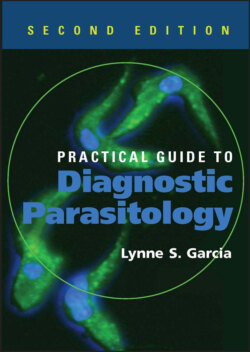Читать книгу Practical Guide to Diagnostic Parasitology - Lynne Shore Garcia - Страница 48
На сайте Литреса книга снята с продажи.
Protozoa (Intestinal) Amebae
ОглавлениеAmebae are single-celled organisms characterized by having pseudopods (motility) and trophozoite and cyst stages in the life cycle. The cell’s organelles and cytoplasm are enclosed by a cell membrane, such that the cell obtains its food through phagocytosis. However, there are some exceptions in which a cyst form has not been identified. In environments which are potentially lethal to the cell, an ameba may become dormant by surrounding itself with a protective membrane to become a cyst. The cell remains in this form until it encounters more favorable conditions, at which time the organism excysts to release trophozoites. While in the cyst form, amebae do not replicate and may die if unable to excyst for a lengthy period.
Amebae are usually acquired by humans via fecal-oral transmission or mouth-to-mouth contact (Entamoeba gingivalis). In most species, after several nuclear divisions occur, comparable division of the cytoplasm follows excystation. Entamoeba histolytica is the most significant organism within this group.
Although Blastocystis hominis is an enteric protozoan parasite that is commonly found worldwide, the classification is undergoing review. B. hominis has extensive genetic diversity and infects humans and many other animals. Statistically, it may be the most common intestinal parasite recovered. Some of the subtypes are considered to be pathogens while others are probably nonpathogenic, a situation that leads to different opinions regarding pathogenicity. Unfortunately, these subtypes cannot be differentiated on the basis of microscopic morphology. Since there may be a relationship between numbers present and symptoms, this is one of the few parasites whose numbers should be specified in the report (rare, few, moderate, many, packed). It is recommended that quantitation be determined from the permanent stained smear.
Representative organisms include Entamoeba histolytica, Entamoeba dispar, Entamoeba coli, Entamoeba hartmanni, Entamoeba gingivalis, Endolimax nana, Iodamoeba bütschlii, and Blastocystis hominis.
